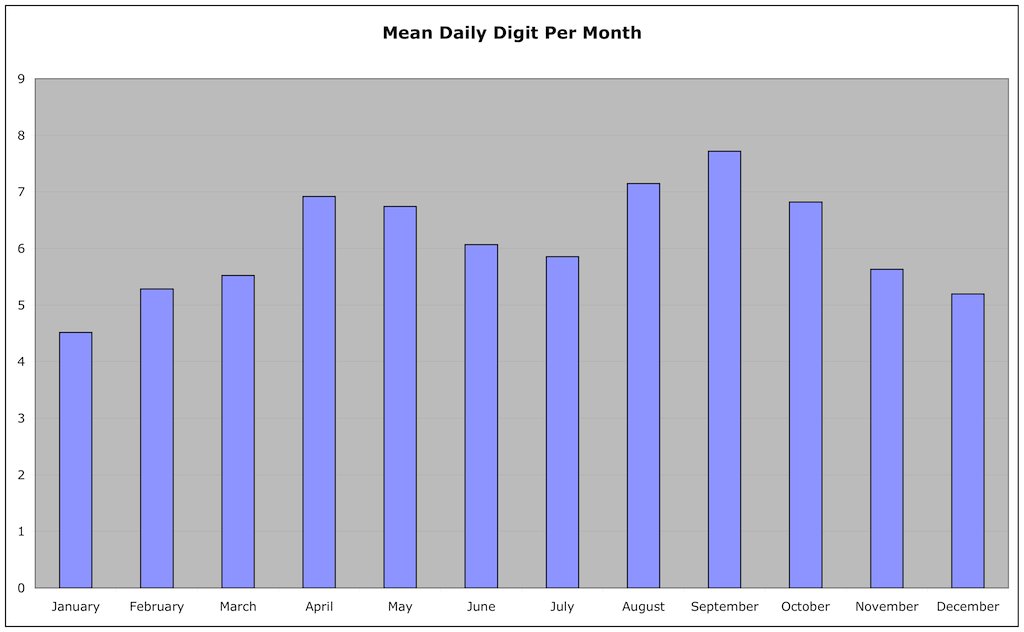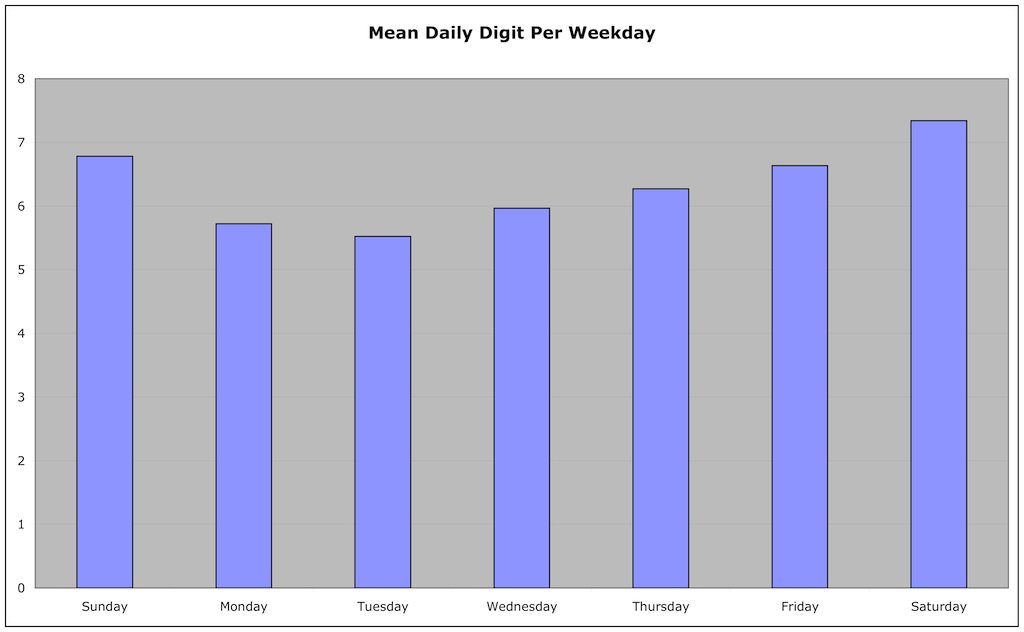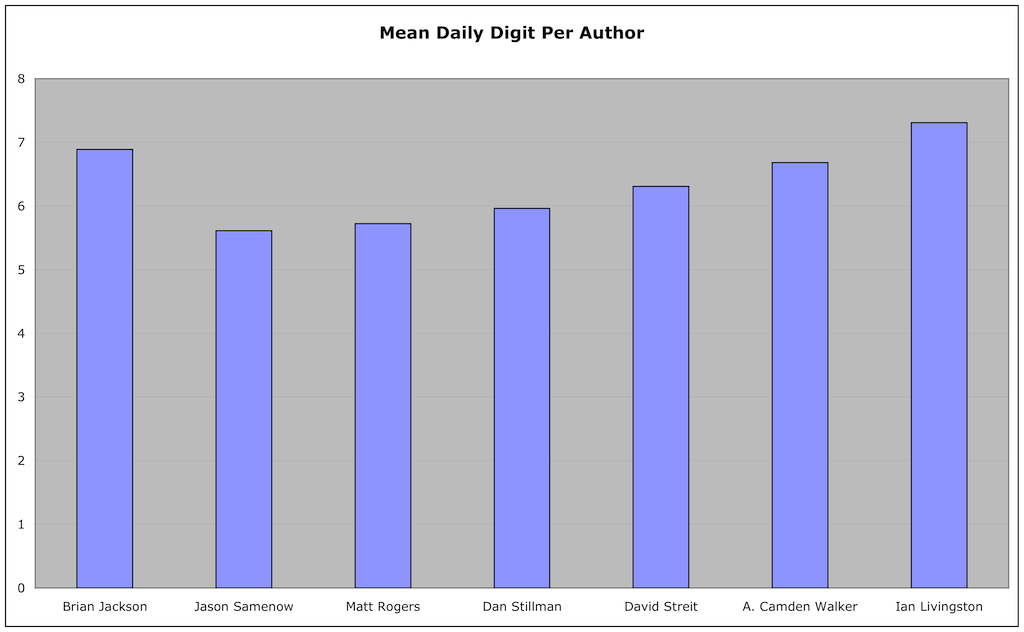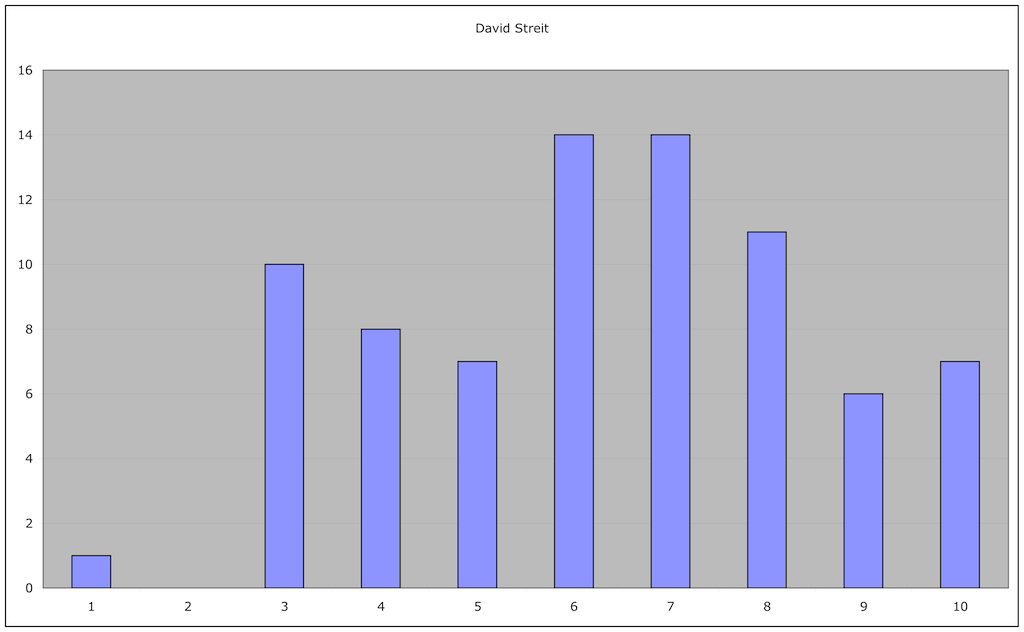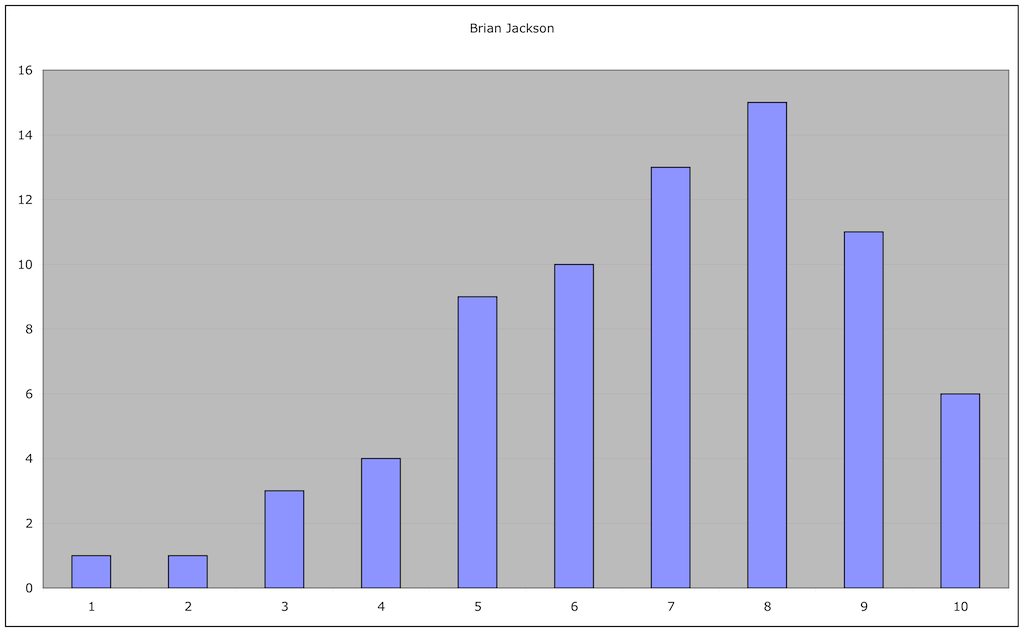I was curious about the chances of finding various small dollar coins in circulation. I imported the mintage values for each year/mint/series into a spreadsheet, and created the following table.
For each coin, the mintage is shown, along with that mintage as a percentage of the total number of small dollar coins minted, which happens to be 5,222,246,560.
I then computed two other numbers for each coin:
Rank – A ranking of coins by most common (2000-P Sacagawea) to least common (2023-D Mississippi Innovation).
One Out of Every – Essentially the inverse of percentage. For example, for 2000-P Sacagawea it’s 7, which means that (roughly) 1 out of 7 coins are this. For the 1979-P Susan B. Anthony, 1/14. And so on. For clarity, values are rounded to the nearest integer. You could treat this, very crudely, as an estimate of how many coins you would need to search to find one of these.
Several caveats:
I do include the NIFC (Not Intended For Circulation) strikes. Those coins that, officially at least, were only sold to collectors. I suspect that in addition to some being dumped into circulation by individuals, the US Mint / Treasury release unsold NIFC coins into circulation. From my experience coin roll hunting, they do turn up much more often than I’d expect.
I do not include proofs. Yes, they turn up now and then, but only when someone releases one into circulation. For most years/series, 2 to 3 million proofs were minted. Fewer for recent years of Presidential and Native American coins, and far fewer for Innovation Dollars. They turn up in significantly smaller numbers than the NIFC strikes. I’m not sure it would be worth adding proofs to the table, as I think the suggested chances of finding them would be highly inflated.
Speaking of Innovation Dollars… their total mintage (to date) is 18,844,500, or 0.361% of all small dollars. If they were all in circulation (which they are not), the odds of finding one would be 1 in 277. From experience, my actual results are much worse than this. This suggests the odds for each member of the series in the table below is indeed inflated, as most never entered circulation.
The table is a mix of P and D mint coins. If you live between the two mints, perhaps you see nearly equal numbers of each. I live in MD, very close to the Philadelphia mint. Obviously, I see primarily P minted coins. D coins turn up, but in in much smaller numbers. Therefore I am much less likely to find D mint coins than the table suggests, and more likely to find P mint coins. The converse would be true for those in the western states.
Based on my penny coin roll hunting results, older D mint coins are much more likely to turn up here. This makes sense, the longer a coin is in circulation, the more time it has to work its way around the country. For the 1960s and back (wheat cents included) I tend to find roughly equal numbers of P and D cents, relative to their mintages. Fewer S mint pennies from 1968-1974, even taking into account their very low mintages, but that’s to be expected since they need to travel further.
OTOH, for recent years, D mint pennies are much less common here. They have not had enough time to work their way east. I assume this works the same way for those in the West, with respect to P mint coins.
Here’s a graph of my penny results. It’s somewhat convoluted based on how I set aside coins and count them, but I think you will get the idea:
Small dollar coins only date back to 1979, they’ve had less time to move around the country. Most of them have had very little time, this is reflected in how much more difficult they are for me to find.
To summarize:
For those coins where there were circulating business strikes, the table does an adequate job estimating how easy it is to find them, if you ignore the P/D mint issues (you live somewhere between the mints, and generally see a good mix of coins from both mints). Otherwise, you should keep in mind that it is going to be more difficult to find coins from the “other” mint than the table suggests.
For NIFC strikes, the table likely over-estimates your chances of finding coins, possibly significantly.
It might be best to treat the numbers in a relative, vs absolute, fashion.
After your done reading through this, head on over to my website Black Cat Systems and take a look at the software I write and sell. Maybe you will find something useful!
| Year / Mint / Coin | Mintage | Percent | One Out Of Every | Rank |
| 1979-P SBA | 360,222,000 | 6.8978 | 14 | 3 |
| 1979-D SBA | 288,015,744 | 5.5152 | 18 | 4 |
| 1979-S SBA | 109,576,000 | 2.0983 | 48 | 9 |
| 1980-P SBA | 27,610,000 | 0.5287 | 189 | 56 |
| 1980-D SBA | 41,628,708 | 0.7971 | 125 | 34 |
| 1980-S SBA | 20,422,000 | 0.3911 | 256 | 57 |
| 1981-P SBA | 3,000,000 | 0.0574 | 1,741 | 108 |
| 1981-D SBA | 3,250,000 | 0.0622 | 1,607 | 103 |
| 1981-S SBA | 3,492,000 | 0.0669 | 1,495 | 99 |
| 1999-P | 29,592,000 | 0.5667 | 176 | 54 |
| 1999-D SBA | 11,776,000 | 0.2255 | 443 | 58 |
| 2000-P Sacagawea | 767,140,000 | 14.6898 | 7 | 1 |
| 2000-D Sacagawea | 518,916,000 | 9.9366 | 10 | 2 |
| 2001-P Sacagawea | 62,468,000 | 1.1962 | 84 | 16 |
| 2001-D Sacagawea | 70,939,500 | 1.3584 | 74 | 14 |
| 2002-P Sacagawea | 3,865,610 | 0.074 | 1,351 | 91 |
| 2002-D Sacagawea | 3,732,000 | 0.0715 | 1,399 | 95 |
| 2003-P Sacagawea | 3,080,000 | 0.059 | 1,696 | 104 |
| 2003-D Sacagawea | 3,080,000 | 0.059 | 1,696 | 105 |
| 2004-P Sacagawea | 2,660,000 | 0.0509 | 1,963 | 114 |
| 2004-D Sacagawea | 2,660,000 | 0.0509 | 1,963 | 115 |
| 2005-P Sacagawea | 2,520,000 | 0.0483 | 2,072 | 116 |
| 2005-D Sacagawea | 2,520,000 | 0.0483 | 2,072 | 117 |
| 2006-P Sacagawea | 4,900,000 | 0.0938 | 1,066 | 73 |
| 2006-D Sacagawea | 2,800,000 | 0.0536 | 1,865 | 109 |
| 2007-P Sacagawea | 3,640,000 | 0.0697 | 1,435 | 97 |
| 2007-D Sacagawea | 3,920,000 | 0.0751 | 1,332 | 87 |
| 2008-P Sacagawea | 1,820,000 | 0.0349 | 2,869 | 120 |
| 2008-D Sacagawea | 1,820,000 | 0.0349 | 2,869 | 121 |
| 2009-P Native American | 39,200,000 | 0.7506 | 133 | 36 |
| 2009-D Native American | 35,700,000 | 0.6836 | 146 | 51 |
| 2010-P Native American | 32,060,000 | 0.6139 | 163 | 53 |
| 2010-D Native American | 48,720,000 | 0.9329 | 107 | 26 |
| 2011-P Native American | 29,400,000 | 0.563 | 178 | 55 |
| 2011-D Native American | 48,160,000 | 0.9222 | 108 | 27 |
| 2012-P Native American | 2,800,000 | 0.0536 | 1,865 | 110 |
| 2012-D Native American | 3,080,000 | 0.059 | 1,696 | 106 |
| 2013-P Native American | 1,820,000 | 0.0349 | 2,869 | 122 |
| 2013-D Native American | 1,820,000 | 0.0349 | 2,869 | 123 |
| 2014-P Native American | 3,080,000 | 0.059 | 1,696 | 107 |
| 2014-D Native American | 2,800,000 | 0.0536 | 1,865 | 111 |
| 2015-P Native American | 2,800,000 | 0.0536 | 1,865 | 112 |
| 2015-D Native American | 2,240,000 | 0.0429 | 2,331 | 118 |
| 2016-P Native American | 2,800,000 | 0.0536 | 1,865 | 113 |
| 2016-D Native American | 2,100,000 | 0.0402 | 2,487 | 119 |
| 2017-P Native American | 1,820,000 | 0.0349 | 2,869 | 124 |
| 2017-D Native American | 1,540,000 | 0.0295 | 3,391 | 125 |
| 2018-P Native American | 1,400,000 | 0.0268 | 3,730 | 128 |
| 2018-D Native American | 1,400,000 | 0.0268 | 3,730 | 129 |
| 2019-P Native American | 1,400,000 | 0.0268 | 3,730 | 130 |
| 2019-D Native American | 1,540,000 | 0.0295 | 3,391 | 126 |
| 2020-P Native American | 1,260,000 | 0.0241 | 4,145 | 132 |
| 2020-D Native American | 1,260,000 | 0.0241 | 4,145 | 133 |
| 2021-P Native American | 1,400,000 | 0.0268 | 3,730 | 131 |
| 2021-D Native American | 1,260,000 | 0.0241 | 4,145 | 134 |
| 2022-P Native American | 980,000 | 0.0188 | 5,329 | 138 |
| 2022-D Native American | 980,000 | 0.0188 | 5,329 | 139 |
| 2023-P Native American | 1,120,000 | 0.0214 | 4,663 | 136 |
| 2023-D Native American | 1,120,000 | 0.0214 | 4,663 | 137 |
| 2007-P George Washington | 176,680,000 | 3.3832 | 30 | 5 |
| 2007-D George Washington | 163,680,000 | 3.1343 | 32 | 6 |
| 2007-P John Adams | 112,420,000 | 2.1527 | 46 | 7 |
| 2007-D John Adams | 112,140,000 | 2.1474 | 47 | 8 |
| 2007-P Thomas Jefferson | 100,800,000 | 1.9302 | 52 | 11 |
| 2007-D Thomas Jefferson | 102,810,000 | 1.9687 | 51 | 10 |
| 2007-P James Madison | 84,560,000 | 1.6192 | 62 | 13 |
| 2007-D James Madison | 87,780,000 | 1.6809 | 59 | 12 |
| 2008-P James Monroe | 64,260,000 | 1.2305 | 81 | 15 |
| 2008-D James Monroe | 60,230,000 | 1.1533 | 87 | 19 |
| 2008-P John Quincy Adams | 57,540,000 | 1.1018 | 91 | 21 |
| 2008-D John Quincy Adams | 57,720,000 | 1.1053 | 90 | 20 |
| 2008-P Andrew Jackson | 61,180,000 | 1.1715 | 85 | 17 |
| 2008-D Andrew Jackson | 61,070,000 | 1.1694 | 86 | 18 |
| 2008-P Martin Van Buren | 51,520,000 | 0.9865 | 101 | 23 |
| 2008-D Martin Van Buren | 50,960,000 | 0.9758 | 102 | 24 |
| 2009-P William Henry Harrison | 43,260,000 | 0.8284 | 121 | 32 |
| 2009-D William Henry Harrison | 55,160,000 | 1.0563 | 95 | 22 |
| 2009-P John Tyler | 43,540,000 | 0.8337 | 120 | 30 |
| 2009-D John Tyler | 43,540,000 | 0.8337 | 120 | 31 |
| 2009-P James K. Polk | 46,620,000 | 0.8927 | 112 | 29 |
| 2009-D James K. Polk | 41,720,000 | 0.7989 | 125 | 33 |
| 2009-P Zachary Taylor | 41,580,000 | 0.7962 | 126 | 35 |
| 2009-D Zachary Taylor | 36,680,000 | 0.7024 | 142 | 49 |
| 2010-P Millard Fillmore | 37,520,000 | 0.7185 | 139 | 42 |
| 2010-D Millard Fillmore | 36,960,000 | 0.7077 | 141 | 46 |
| 2010-P Franklin Pierce | 38,220,000 | 0.7319 | 137 | 38 |
| 2010-D Franklin Pierce | 38,360,000 | 0.7345 | 136 | 37 |
| 2010-P James Buchanan | 36,820,000 | 0.7051 | 142 | 47 |
| 2010-D James Buchanan | 36,540,000 | 0.6997 | 143 | 50 |
| 2010-P Abraham Lincoln | 49,000,000 | 0.9383 | 107 | 25 |
| 2010-D Abraham Lincoln | 48,020,000 | 0.9195 | 109 | 28 |
| 2011-P Andrew Johnson | 35,560,000 | 0.6809 | 147 | 52 |
| 2011-D Andrew Johnson | 37,100,000 | 0.7104 | 141 | 43 |
| 2011-P Ulysses S. Grant | 38,080,000 | 0.7292 | 137 | 39 |
| 2011-D Ulysses S. Grant | 37,940,000 | 0.7265 | 138 | 40 |
| 2011-P Rutherford B. Hayes | 37,660,000 | 0.7211 | 139 | 41 |
| 2011-D Rutherford B. Hayes | 36,820,000 | 0.7051 | 142 | 48 |
| 2011-P James Garfield | 37,100,000 | 0.7104 | 141 | 44 |
| 2011-D James Garfield | 37,100,000 | 0.7104 | 141 | 45 |
| 2012-P Chester Arthur | 6,020,000 | 0.1153 | 867 | 64 |
| 2012-D Chester Arthur | 4,060,000 | 0.0777 | 1,286 | 85 |
| 2012-P Grover Cleveland (1st Term) | 5,460,000 | 0.1046 | 956 | 67 |
| 2012-D Grover Cleveland (1st Term) | 4,060,000 | 0.0777 | 1,286 | 86 |
| 2012-P Benjamin Harrison | 5,640,000 | 0.108 | 926 | 66 |
| 2012-D Benjamin Harrison | 4,200,000 | 0.0804 | 1,243 | 83 |
| 2012-P Grover Cleveland (2nd Term) | 10,680,000 | 0.2045 | 489 | 59 |
| 2012-D Grover Cleveland (2nd Term) | 3,920,000 | 0.0751 | 1,332 | 88 |
| 2013-P William McKinley | 4,760,000 | 0.0911 | 1,097 | 76 |
| 2013-D William McKinley | 3,365,100 | 0.0644 | 1,552 | 100 |
| 2013-P Theodore Roosevelt | 5,310,700 | 0.1017 | 983 | 70 |
| 2013-D Theodore Roosevelt | 3,920,000 | 0.0751 | 1,332 | 89 |
| 2013-P William Howard Taft | 4,760,000 | 0.0911 | 1,097 | 77 |
| 2013-D William Howard Taft | 3,360,000 | 0.0643 | 1,554 | 101 |
| 2013-P Woodrow Wilson | 4,620,000 | 0.0885 | 1,130 | 79 |
| 2013-D Woodrow Wilson | 3,360,000 | 0.0643 | 1,554 | 102 |
| 2014-P Warren G. Harding | 6,160,000 | 0.118 | 848 | 62 |
| 2014-D Warren G. Harding | 3,780,000 | 0.0724 | 1,382 | 92 |
| 2014-P Calvin Coolidge | 4,480,000 | 0.0858 | 1,166 | 80 |
| 2014-D Calvin Coolidge | 3,780,000 | 0.0724 | 1,382 | 93 |
| 2014-P Herbert Hoover | 4,480,000 | 0.0858 | 1,166 | 81 |
| 2014-D Herbert Hoover | 3,780,000 | 0.0724 | 1,382 | 94 |
| 2014-P Franklin D. Roosevelt | 4,760,000 | 0.0911 | 1,097 | 78 |
| 2014-D Franklin D. Roosevelt | 3,920,000 | 0.0751 | 1,332 | 90 |
| 2015-P Harry S. Truman | 4,900,000 | 0.0938 | 1,066 | 74 |
| 2015-D Harry S. Truman | 3,500,000 | 0.067 | 1,492 | 98 |
| 2015-P Dwight D. Eisenhower | 4,900,000 | 0.0938 | 1,066 | 75 |
| 2015-D Dwight D. Eisenhower | 3,645,998 | 0.0698 | 1,432 | 96 |
| 2015-P John F. Kennedy | 6,160,000 | 0.118 | 848 | 63 |
| 2015-D John F. Kennedy | 5,180,000 | 0.0992 | 1,008 | 71 |
| 2015-P Lyndon B. Johnson | 7,840,000 | 0.1501 | 666 | 60 |
| 2015-D Lyndon B. Johnson | 4,200,000 | 0.0804 | 1,243 | 84 |
| 2016-P Richard M. Nixon | 5,460,000 | 0.1046 | 956 | 68 |
| 2016-D Richard M. Nixon | 4,340,000 | 0.0831 | 1,203 | 82 |
| 2016-P Gerald R. Ford | 5,460,000 | 0.1046 | 956 | 69 |
| 2016-D Gerald R. Ford | 5,040,000 | 0.0965 | 1,036 | 72 |
| 2016-P Ronald Reagan | 7,140,000 | 0.1367 | 731 | 61 |
| 2016-D Ronald Reagan | 5,880,000 | 0.1126 | 888 | 65 |
| 2020-P George H.W. Bush | 1,242,275 | 0.0238 | 4,204 | 135 |
| 2020-D George H.W. Bush | 1,502,425 | 0.0288 | 3,476 | 127 |
| 2018-P Introductory | 502,150 | 0.0096 | 10,400 | 142 |
| 2018-D Introductory | 582,825 | 0.0112 | 8,960 | 140 |
| 2019-P Delaware | 472,750 | 0.0091 | 11,047 | 148 |
| 2019-D Delaware | 479,975 | 0.0092 | 10,880 | 145 |
| 2019-P Pennsylvania | 490,200 | 0.0094 | 10,653 | 144 |
| 2019-D Pennsylvania | 443,800 | 0.0085 | 11,767 | 165 |
| 2019-P New Jersey | 521,175 | 0.01 | 10,020 | 141 |
| 2019-D New Jersey | 476,275 | 0.0091 | 10,965 | 146 |
| 2019-P Georgia | 474,550 | 0.0091 | 11,005 | 147 |
| 2019-D Georgia | 455,800 | 0.0087 | 11,457 | 150 |
| 2020-P Connecticut | 436,000 | 0.0083 | 11,978 | 169 |
| 2020-D Connecticut | 435,325 | 0.0083 | 11,996 | 171 |
| 2020-P Massachusetts | 436,750 | 0.0084 | 11,957 | 167 |
| 2020-D Massachusetts | 436,425 | 0.0084 | 11,966 | 168 |
| 2020-P Maryland | 434,825 | 0.0083 | 12,010 | 172 |
| 2020-D Maryland | 435,475 | 0.0083 | 11,992 | 170 |
| 2020-P South Carolina | 432,850 | 0.0083 | 12,065 | 173 |
| 2020-D South Carolina | 397,775 | 0.0076 | 13,129 | 178 |
| 2021-P New Hampshire | 453,825 | 0.0087 | 11,507 | 153 |
| 2021-D New Hampshire | 450,725 | 0.0086 | 11,586 | 162 |
| 2021-P Virginia | 423,600 | 0.0081 | 12,328 | 174 |
| 2021-D Virginia | 422,875 | 0.0081 | 12,349 | 175 |
| 2021-P New York | 451,750 | 0.0087 | 11,560 | 160 |
| 2021-D New York | 451,175 | 0.0086 | 11,575 | 161 |
| 2021-P North Carolina | 405,950 | 0.0078 | 12,864 | 177 |
| 2021-D North Carolina | 389,725 | 0.0075 | 13,400 | 179 |
| 2022-P Rhode Island | 454,050 | 0.0087 | 11,501 | 152 |
| 2022-D Rhode Island | 453,775 | 0.0087 | 11,508 | 154 |
| 2022-P Vermont | 454,275 | 0.0087 | 11,496 | 151 |
| 2022-D Vermont | 452,775 | 0.0087 | 11,534 | 155 |
| 2022-P Kentucky | 451,900 | 0.0087 | 11,556 | 159 |
| 2022-D Kentucky | 452,550 | 0.0087 | 11,540 | 156 |
| 2022-P Tennessee | 452,325 | 0.0087 | 11,545 | 157 |
| 2022-D Tennessee | 452,275 | 0.0087 | 11,547 | 158 |
| 2023-P Ohio | 495,125 | 0.0095 | 10,547 | 143 |
| 2023-D Ohio | 447,450 | 0.0086 | 11,671 | 163 |
| 2023-P Louisiana | 444,625 | 0.0085 | 11,745 | 164 |
| 2023-D Louisiana | 411,950 | 0.0079 | 12,677 | 176 |
| 2023-P Indiana | 459,775 | 0.0088 | 11,358 | 149 |
| 2023-D Indiana | 443,650 | 0.0085 | 11,771 | 166 |
| 2023-P Mississippi | 371,000 | 0.0071 | 14,076 | 180 |
| 2023-D Mississippi | 352,450 | 0.0067 | 14,817 | 181 |















